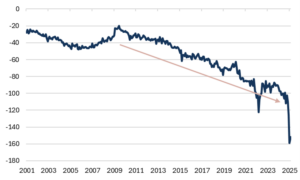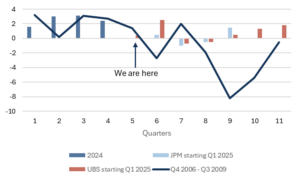Seriously and Literally, Part II
Seriously and Literally, Part II
There is a famous saying that those who cannot remember the past are doomed to repeat it. It is equally true, with credit to Joe Wiesenthal of Bloomberg News, that those who know history are doomed to think it’s repeating. We don’t want to fall prey to either cognitive error, and assuming that 2025 is a replay of 1930 would be such an error.
President Trump’s tariffs make a US recession more likely, but certainly not inevitable, and the Fed’s response will be very important over the next year. In short, we see continued market stress and distress as well as opportunities.
While stock markets have experienced a historically fast decline, balanced 60/40 stock/bond portfolios have declined approximately 5% year-to-date; unpleasant, yes, but hardly extraordinary.
In that vein, we will be consistent and reiterate our message from early March: We continue to encourage investors to hold well-diversified equity portfolios and rebalance if necessary. For reference, our target exposure to international equities is 34% of an equity portfolio. We recognize that taxes and other considerations can prevent investors from matching our suggested target allocation.
We also continue to strongly recommend diversifying out of public stocks and bonds and into alternative income strategies (e.g., private credit, farmland, and stabilized multifamily real estate) and private equity. Our investment committee also recently approved a value-add real estate strategy that we believe will be accretive and diversifying to portfolios.
Tariffs, then and now
The 1930 Smoot-Hawley Act, which was the last significant tariff action in the US, was an economic and market disaster. The US economy contracted significantly in 1930, 1931, and 1932, worsening an ongoing recession into the Great Depression. US markets fell 5.8% the day after President Hoover signaled his intent to sign Smoot-Hawley, began a sustained downturn, and did not return to their 1930 levels until 1955. Assuming we’re going to experience the same outcome as in the early 1930s does not account for the differences in the US economy then versus now.
The current United States shares little in common with the 1930s United States. First, the economic backdrop in 1930 was an economy in severe recession. We are going into the current tariff shock with a healthy labor market and inflation near the Fed’s 2% target. Second, the US is no longer on the gold standard, which created a horrible deflationary spiral that exacerbated the policy mistakes of the 1930s. We currently have a Federal Reserve that is tasked with providing an appropriate monetary offset (i.e., lowering the Fed Funds rate) to economic damage caused by tariffs. Third, the 1930 tariffs were an act of Congress that required legislative action to remove. Today, our tariffs were initiated by executive action and can be modified or removed quickly through executive action. Like in the 1930s, we expect retaliation and potential escalation, but also negotiations, legal challenges, and political pushback that will lessen the overall impact. It will not be a straight line from President Trump’s announcement to a resolution, but we’re already seeing movement on those fronts.
A note about trade imbalances
In our opinion, concerns about trade imbalances, unfair trade practices, and big currency misalignments are bipartisan and reasonable. The US has run large trade deficits for decades and they have recently expanded in a way that indicates shrinking competitiveness in US-manufactured global tradeable goods (Fig. 1).
Fig. 1: US non-petrol trade balance (Billions)

Source: Bloomberg, Mill Creek.
We also agree with the general economic and political consensus that China has been a particularly bad trade actor. For example, the Biden Administration compiled a list of significant Chinese non-tariff trade barriers in this 2022 USTR report, the Council on Foreign Relations has flagged growing US-China trade imbalances, and the St. Louis Fed recently published an article showing “China’s strategic shift toward high-value innovation and its growing role as a direct competitor in technology-intensive industries traditionally dominated by developed nations.” The implication of the article is that China intentionally targets high-value manufacturing from developed nations through unfair trade practices.
It is our practice not to comment on political policy. However, the formulation of the reciprocal tariff rates was, in our opinion, economically incoherent. As we explained in our note Thursday morning, the administration has redefined “tariffs and trade barriers” as “the existence of bilateral trade deficits” and left little room for an off-ramp with many trading partners. We believe the chosen policy tool is more likely to rebalance trade by shrinking imports into the US than by expanding exports from the US – a net negative for economic growth and global equity markets.
Economic impact
High tariff barriers will lead to higher inflation and lower growth (stagflation) as the economy adjusts. Professional forecasters have begun updating their economic projections to incorporate the tariff impact. If implemented as announced and assuming some retaliation from foreign countries, the economic impact could be about 1/3rd of the 2008-2009 financial crisis. However, most of the updated forecasts that we’ve seen are not penciling in that level of economic impact (Fig. 2).
Fig. 2: Economic growth forecasts (%, seasonally adjusted annual rate)

Source: Bloomberg, JPM, UBS, Mill Creek.
A mix of higher inflation and lower growth is challenging for monetary policy to address and we don’t expect the Federal Reserve to preemptively rush to the rescue. While FOMC Chair Powell didn’t quite get to the level of “Ford to City: Drop Dead,” he wasn’t too far off in his comments on Friday. However, the Fed will step in, when and if necessary, to fulfill their mandate to support the US economy. We do not expect to see a replay of the 1930s or 1970s at this time.
Market impact
In “Seriously and Literally” (March 10, 2025), we said, “the path to achieving the policies that Secretary Bessent laid out will disrupt the current economic order and create continued uncertainty and volatility in markets.” In retrospect, it was an understatement.
The two-day decline of -10.5% in the S&P 500 was an event on par with the COVID sell-off and global financial crisis. Equity implied volatility, as measured by the VIX Index, rose to over 40 on Friday, signaling extreme fear. The 10-year Treasury yield dropped below 4%, and long-term inflation expectations (looking past the initial impact of tariffs) fell to 2%.
We believe that neither extreme fear nor extreme greed, as it pertains to the recent movement in equity prices, is warranted at this point. The S&P 500 is 17.5% below its all-time high earlier this year. The average intra-year decline in the S&P 500 since 1925 has been about 16%. While much of the valuation froth in US equities has been removed over the last few days and weeks, US equity valuations have not fallen to levels we’d consider cheap and tariff policy will remain a headwind for equity markets, in general, as long as the trade war continues. Investors that have been dollar cost averaging into equities can accelerate a tranche and we recommend rebalancing back to neutral equity exposure (an investor’s long-term target) following the recent sell-off, but we wouldn’t go further than that.
Fixed income is also a mixed bag. We believe high-quality bonds will remain a safe haven asset, but an escalating trade war and currently hands-off Fed have weakened the fundamental appeal of bonds. Those with near-term cash needs can draw on their cash and fixed income exposures, which have held up well over recent weeks, allowing risk assets time to recover. We remain underweight fixed income in favor of alternative income strategies like private credit and specialty finance.
Within private credit, we have minimal exposure to pure consumer-based companies or those with manufacturing/supply chains that rely heavily on foreign partners and believe the value of in-place infrastructure, equipment, real estate, etc., will naturally rise if it now costs more to source materials externally.
One bright spot could be real estate. Labor and ‘soft costs’ (legal, insurance, permits, etc.) are the largest expense items in a construction project. Materials make up just 25%-30% of costs and most materials are either 1) exempt from tariffs or 2) sourced domestically. Further, lower interest rates have a much bigger impact/benefit on the profitability of a project in real estate than the drag from a 10%-20% increase in material costs.
To conclude, for the first time since COVID investors face a real test. We encourage everyone to maintain a sober perspective in the current environment. We believe defensive positioning through well-diversified portfolios as we’ve described earlier is warranted; rash actions like liquidating portfolios are not. We’re available at any time to discuss the current environment by phone or email.
Disclosures & Important Information
Any views expressed above represent the opinions of Mill Creek Capital Advisers ("MCCA") and are not intended as a forecast or guarantee of future results. This information is for educational purposes only. It is not intended to provide, and should not be relied upon for, particular investment advice. This publication has been prepared by MCCA. The publication is provided for information purposes only. The information contained in this publication has been obtained from sources that
MCCA believes to be reliable, but MCCA does not represent or warrant that it is accurate or complete. The views in this publication are those of MCCA and are subject to change, and MCCA has no obligation to update its opinions or the information in this publication. While MCCA has obtained information believed to be reliable, MCCA, nor any of their respective officers, partners, or employees accepts any liability whatsoever for any direct or consequential loss arising from any use of this publication or its contents.
© 2025 All rights reserved. Trademarks “Mill Creek,” “Mill Creek Capital” and “Mill Creek Capital Advisors” are the exclusive property of Mill Creek Capital Advisors, LLC, are registered in the U.S. Patent and Trademark Office, and may not be used without written permission.